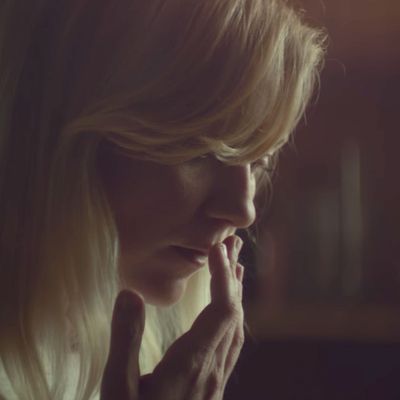
If it weren’t for the fact that a large portion of it takes place at a weed dispensary, Woodshock could easily be mistaken for a period piece set at any point in the last 40 years. You’ve got Kirsten Dunst in nearly every frame, an actress who with continues to evoke a kind of sad-eyed ’70s art-film starlet of the mind long after her turn in The Virgin Suicides. The aesthetics are all ambiguously retro, and gauzed up through a nostalgia filter of glass reflections, double-exposed flora, and more likely than not, actual gauze. The directors are Laura and Kate Mulleavy, better known by their fashion label Rodarte, which rose to “It” status in the mid 2000s thanks to the sisters’ intricately inventive, one-of-a-kind looks. But for the most part, Woodshock, their directorial debut, doesn’t feel like a fashion movie, perhaps until its closing moments. This is a full-blown art movie by first-time filmmakers, with all the positive and negative connotations that status comes with.
First, the positive: Perhaps predictably, the Mulleavys’ visual milieu is assured and just unexpected enough. Following Dunst’s dispensary employee Theresa as she grieves the death of her mother, the film is deeply Californian, particularly the Northern variety, in a way we don’t see onscreen too often. Neon, redwoods, and sticky kush form the backbone of the film’s iconography, appropriate for a film about hallucinatory bridge between life and death. It could have very well just been about Theresa being sad and high and wearing fabulous outfits, but the Mulleavys are refreshingly circumspect about the looks and clearly more visually interested in the dreamspace Theresa descends into.
About that dreamspace: The film begins when Theresa administers an assisted suicide to her ailing mother, via an unexplained serum mixed with marijuana and smoked on her deathbed. The absence of her mother haunts Theresa, particularly when her boyfriend Nick (Joe Cole) moves in with her to her mother’s now-vacant house. “She wanted us to have it,” Theresa explains, though we are certainly given no evidence of that. It seems more likely that some kind of codependent bond is keeping Theresa tied to the house, eventually sending her on a guilt-ridden, self-destructive path in which she begins tempting fate by smoking the deadly mixture herself. At different points, while under the drug’s influence, she sees geometric patterns overlaying her vision, imagines entire episodes between her and her boss (Pilou Asbaek), and returns to a recurring hallucination of sorts among a grove of towering redwoods.
Peter Flinckenberg’s camera brings plenty of emotionality to these images, even if every figure onscreen feels half-formed compared to Dunst (who herself remains a cipher, but at least an empathetic one). The film feels as though it’s already half-departed this Earth from the start, barely interested in what the lowly non-death-weed smoking characters are up to and what drives them. I have no idea what the sisters are trying to say about assisted suicide, or Theresa’s relationship to the wilderness that surrounds her and invades her dreams.
Still, I can’t say that I wasn’t willing to follow the Mulleavys down their ruminative, starry-eyed path, and found its jarringly violent conclusion both ridiculous and admirable. I caught myself, in the orchestral swell of the film’s final moments, thinking, “This must be what it felt like to not hate Mother!,” Darren Aronofsky’s audacious not-quite-horror film that has thrown the film community (and pretty much nobody else) into rancorous controversy. I’ll say this much, I was much more captivated by Dunst wandering around and touching the interior of her possibly haunted metaphor house than Jennifer Lawrence doing the same, mostly because Woodshock is the noncommittal ellipses to Aronofsky’s preachy exclamation point. (Who knows if the Mulleavys even picked up an idea or two on the set of Aronofsky’s Black Swan, for which they designed costumes for?) There are a lot of half-complete ideas among the sisters’ jumble of imagery, but trying to tie them together is a fitfully enjoyable, if ultimately fruitless experience.

